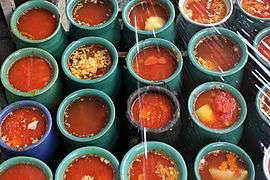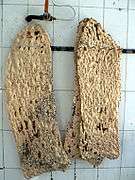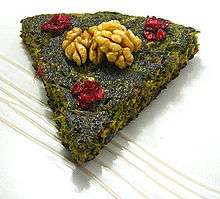Iranian cuisine
| Part of a series on the |
| Culture of Iran |
|---|
 |
|
|
Iranian cuisine includes the foods, cooking methods, and food traditions of Iranians.
Iranian culinary styles share historical interactions with the cuisines of the neighboring regions, including Caucasian cuisine, abroad Kurdish cuisine, Turkish cuisine, Iraqi cuisine, Levantine cuisine, Greek cuisine, Central Asian cuisine, and Russian cuisine.[1][2][3][4] Through the Persianized Central Asian Mughal dynasty, aspects of Iranian cuisine were adopted into North Indian cuisine.[5]
Typical Iranian main dishes are combinations of rice with meat (such as lamb, chicken, or fish), vegetables (such as onions and various herbs), and nuts. Fresh green herbs are frequently used, along with fruits such as plums, pomegranate, quince, prunes, apricots, and raisins. Characteristic Iranian flavorings such as saffron, dried lime, cinnamon, and parsley are mixed and used in some special dishes.
National cuisine
Dishes
Iranian cuisine includes a wide variety of foods ranging from Chelow kabab (white rice served with roasted meat: barg, koobideh, joojeh, shishleek, soltani, chenjeh), khoresh (stew that is served with white Iranian rice: ghormeh sabzi, gheimeh, fesenjān, and others), āsh [6](a thick soup: for example āsh-e anār), kuku (vegetable soufflé), polo (rice mixed meat, vegetables and herbs, including loobia polo, albaloo polo, sabzi polo, zereshk polo, baghali polo, and others), and a diverse variety of salads, such as Shirazi salad, pastries, and drinks specific to different parts of Iran. The list of Iranian recipes, appetizers and desserts is extensive. A famous Iranian dish with sheep brain and hooves is called kaleh pacheh.[7]
Rice
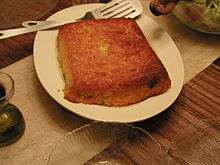

The usage of rice, at first a specialty of Safavid court cuisine, evolved by the end of the 16th century CE into a major branch of Iranian cookery.[8] Varieties of rice in Iran include champa, rasmi, anbarbu, mowlai, sadri, khanjari, shekari, doodi, and others. Traditionally, rice was most prevalent as a major staple item in the rice growing region of northern Iran, and the homes of the wealthy, while in the rest of the country bread was the dominant staple. The varieties of rice most valued in Persian cuisine are prized for their aroma, and grow in the north of Iran.
Cooking methods
There are three primary methods of cooking rice in Iran:
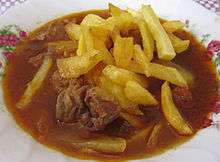
| Method | Description |
|---|---|
| Polo (pilaf) (چوگان بازی) | Chelo is plain rice served as an accompaniment to a stew or kebab (chelo khoresh badenjan, chelo kabab), while Polo is rice mixed with something (such as Baghali Polo, Zereshk polo, Loubia Polo). They are otherwise cooked in the same way. Rice that is prepared by soaking in salted water then boiling it. The parboiled rice (called chelo) is drained and returned to the pot to be steamed. This method results in an exceptionally fluffy rice with the rice grains separated and not sticky. A golden rice crust is created at the bottom of the pot called Tah-deeg (literally "bottom of the pot"). Tah-deeg is served plain, with thin bread such as lavash or slices of potato. Meat, vegetables, nuts and fruits are sometimes added in layers or completely mixed with the chelo and then steamed, such as Baghali Polo, Lubia Polo, Zereshk Polo, and Sabzi Polo. When chelo is in the pot the heat is reduced and a piece of thick cloth or towel is place on top of the pot to absorb excess steam. |
| Kateh (کته) | Rice that is cooked until the water is absorbed completely. This is also the traditional dish of Gilan Province (described in detail below). |
| Damy (خانم) | Rice that is cooked almost the same as Kateh but at the start ingredients that can be cooked thoroughly with the rice are added such as grains and beans like lentils in "Adass Polo". In making Kateh the heat is reduced to minimum when the rice and other ingredients are almost cooked. If kept long enough on the stove without burning and over-cooking Damy and Kateh can also produce Tah-deeg. Damy literally means "steaming". A special form of Damy is Tah-chin, which is a mixture of yogurt, lamb (or chicken) and rice, plus saffron and egg yolks. However, chicken Tah-chin is more common than lamb Tah-chin. |
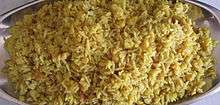
Bread
Second only to rice is the production and use of wheat. There are said to be more than forty types of wheat breads from very dark to very light. Bread is called nān (نان) in Persian, as well as other regional major languages in Iran such as Kurdish, and it has been borrowed as naan in English via Hindustani. There are four major Iranian flat breads:
| Flatbread | Description |
|---|---|
| Nan-e barbari (بربری) | Thick and oval-shaped, also known as Tabrizi Bread or Nan-e Tabrizi, for its origins in and links to the city of Tabriz. |
| Nan-e lavash (لواش) | Thin, flaky and round or oval, and is also the oldest known bread in the Middle East and the Caucasus. It is the most widely eaten bread in Iran as well as neighboring Turkey and the Caucasus. |
| Nan-e sangak (سنگک) | Triangle-shaped bread that is stone-baked. |
| Nan-e taftoon (تافتون) | Thin, but thicker than lavash, soft and round. |
From crisp to limp, at least one type of flat bread will be a part of every meal. Nan-e lavash is an example of the thin crisp bread with good keeping qualities, while nan-e sangak is a fresh yeast bread, baked on hot stones and eaten while still warm.
| Name | Description |
|---|---|
| Nan-e Shirmal | Made like barbari, except with milk instead of water, in addition to a bit of sugar, and is eaten during breakfast or with tea. |
| Nan-e Ghandi | Sweet bread made like taftoon, and is eaten during breakfast or with tea. |
| Nan-e gisu | A sweet Armenian bread, which is eaten in the morning or with tea later in the day. |
| Nan-e dushabi | Bread made with grape syrup |
| Nan-e tiri | Made in a similar way to lavash |
| Nan-e tokhme-ru | Breads with sweet-smelling seeds on them |
| Nan-e khoshke-shirin | Sweet brittle bread baked in gentle heat |
| Nan-e khoshke-tanur | Brittle bread baked in gentle heat |
Fruits and vegetables

Iran's agriculture produces many fruits and vegetables. A bowl of fresh fruit is common on most Iranian tables and dishes of vegetables and herbs are standard sides to most meals.
The climate of the Middle East is conducive to the growing of fruits. These are not only enjoyed fresh and ripe as desserts but are also combined with meats and form accompaniments to main dishes. When fresh fruits are not available, a large variety of dried fruits such as dates, figs, apricots and peaches are used instead. The list of fresh fruits includes dates and figs, many citrus fruits, apricots, peaches, sweet and sour cherries, apples, plums, pears, pomegranates and many varieties of grapes and melons. A small sweet variety of cucumber is popularly served as a fruit. Iran is one of the top date producers in the world; some special date cultivars, such as Rotab, are grown in Iran.
While the eggplant (aubergine) is "the potato of Iran", Iranians are fond of fresh green salads dressed with olive oil, lemon juice, salt and pepper, and a little garlic. Vegetables such as pumpkins, spinach, green beans, broad beans, courgettes, varieties of squashes, onions, garlic and carrots are commonly used in rice and meat dishes. Tomatoes, cucumbers and scallions often accompany a meal.
The term dolma describes any vegetable or fruit stuffed with rice or a rice-and-meat mixture: grape vine leaves, cabbage leaves, spinach, eggplant, sweet peppers, tomatoes, apples and quince. The most popular dolmas in Iran today are stuffed grape leaves, which are prepared by lightly parboiling the fresh leaves in salted water, then stuffing them with a mixture of ground meat, rice, chopped fresh herbs such as parsley, split peas, and seasoning. The dolmas are then simmered in a sweet-and-sour mixture of vinegar or lemon juice, sugar, and water. Fillings vary, however, from region to region and even from family to family. Stuffed cabbage and grape leaves are the only dolmas that can be served hot or cold. When intended to be served cold they generally do not contain meat, however. Fruit dolmas are probably a specialty of Iranian cuisine. The fruit is first cooked, then stuffed with meat, seasonings, and sometimes tomato sauce; the dolmas are then simmered in meat broth or a sweet-and-sour sauce. In recent decades new variations have been introduced, largely under Western influence: Potatoes, artichokes, green peppers, tomatoes, and other vegetables are also stuffed.[9]
A few examples of the main ingredients in Iranian specialties would include duck, pomegranates and walnuts; lamb, prunes and cinnamon; spinach, orange and garlic. Khoresht Beh (quince stew) is an example of using fruits in Iranian cooking: chunks of lamb are stewed with slices or cubes of tart quince and yellow split peas; this dish is always served with rice.[10]
The above are only a few examples of the combination of meats and vegetables, or meats and fruits plus seasonings that may go into chelo khoresh, a favorite Iranian dish that is served at least once daily. This is a dish of crusty baked rice topped by one of the stews listed, or any one of dozens more, limited only by price and availability of ingredients.
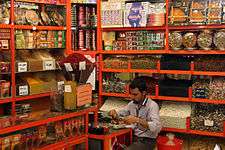
Ab ghoreh, the juice of Ghoreh (unripe grapes) or Verjuice, is used in various Iranian dishes. For example, it is an ingredient in Ash e sagh, a soup prepared with spinach, leeks, yellow split peas, and seasonings. Ab ghoreh is also used to simmer dolma-ye Kadu, which is stuffed summer squash. Ab ghoreh flavors several types of Khoresh like Khoresht-e Alu Esfenaj (stewed lamb with spinach and prunes), Khoresht-e Havij (stewed lamb with carrots), and Khoresht-e Chaghaleh badam (stewed lamb with fresh, unripe almonds). Unripe grapes are used whole in some dishes, such as Khoresht-e ghoreh (lamb stew with sour grapes). Ab ghoreh was frequently used until not too long ago also as a souring agent for a number of pickles, dried pickles, and spices. As a spice, Ghoreh powder (gard-e Ghoreh) was sometimes reinforced by Ab ghoreh and then dried.[11]
Drinks and desserts

The traditional drink accompanying Iranian dishes is doogh, a combination of yogurt, carbonated or plain water, salt, and dried mint. Other drinks include sherbets known as Sharbat and "Khak shir". One favorite is Aab-e Havij, alternately called havij bastani, carrot juice made into an ice cream float and garnished with cinnamon, nutmeg or other spices. There are also drinks that are not served with meals. These include Sheer Moz (banana milk shake), Aab Talebi (cantaloupe juice), and Aab Hendevaneh (watermelon juice). These are commonly made in stands or kiosks in street corners on summer days and on hiking trails. Aab Anaar (pomegranate juice) is also popular and has recently (2007) become popular in North America. Sekanjebin is a thick syrup made from vinegar, mint and sugar, served mixed with carbonated or plain water. It can be drunk mixed with a little rose water or used as a dip for Romaine lettuce.
Dessert dishes range from Bastani-e Za'farāni (Iranian ice cream, also called Bastani-e Akbar-Mashti or Gol-o Bolbol) to faludeh (a frozen sorbet made with thin starch noodles and rose water). Persian ice cream is flavored with saffron, rose water, and includes chunks of heavy cream. There are also many types of sweets, divided into two categories: Shirini Tar (lit. moist pastry) and Shirini Khoshk (lit. dry pastry). The first category consists of French-inspired pastries with heavy whole milk whipped cream, glazed fruit toppings, tarts, custard-filled éclairs, and a variety of cakes. Some have an Iranian twist, such as the addition of saffron, pistachios, and walnuts. The second category consists of more traditional Iranian sweets: Shirini-e Berenji (a type of rice cookie), Shirini-e Nokhodchi (clover-shaped chickpea flour cookies), Kolouche (a large cookie usually with a walnut or fig filling), Shirini-e Keshmeshi (raisin and saffron cookies), Shirini-e Yazdi (small cakes originating from the city of Yazd), Nan-e kulukhi (a kind of large thick cookie without any filling), and others.
Other popular sweets include Zulbia, Bamieh and Gush-e Fil. Bamieh is an oval-shaped piece of sweet dough, deep-fried, and then covered with a syrup traditionally made from honey. Bamieh is similar to tulumba, but much smaller, 2 or 3 centimeters wide at most. Zulubia is made of the same sort of batter, also deep-fried, but poured into the oil in swirls, then covered with the same syrup (or with honey).[12] It is typically described as looking similar to a pretzel. Goosh-e Fil (lit. elephant's ear) is also made of deep-fried dough, in the shape of a flat elephant's ear, and then covered with powdered sugar and topped with pistachios. One of the classics, Halvardeh (Tehrani for halvā-arde, from halvā, an Arabic loan word meaning 'sweet', plus arde, the Persian word for tāhini), comes in various qualities and varieties, from mainly sugar to sesame seed paste (the aforementioned Persian arde) and pistachios.
Noghl, sugar-coated almonds, are often served at Iranian weddings.
Harireh, comparable to Gruel, is a very diluted and light farinaceous Iranian dish made of fine wheat flour or wheat starch, or with rice flour or rice powder; sugar, oil, saffron, ground pistachios, or almonds may also be added. Because of its lightness, most dictionaries consider Harireh to be a suitable diet for sick people, but indeed it is a kind of dessert, which, according to its thickness and use, is variously called Masqati.[13]
Essential accompaniments
There are certain accompaniments (mokhallafât) that are essential to every Iranian lunch (nâhâr) and dinner (shâm), regardless of the region. These include a plate of fresh herbs, called sabzi khordan: basil, cilantro, coriander, fenugreek, green onion, mint, radish (black, red, white), savory (marzeh, origany or sweet fennel), tarragon, and Iranian watercress (shâhi); or a variety of flat breads, called nân or noon (sangak, lavâsh, barbari), fresh white cheese (panir, somewhat similar to feta), walnuts, sliced and peeled cucumbers, sliced tomatoes and onions, yogurt, and lemon juice. Persian gherkins (khiyarshur) and mixed pickles (Torshi) are also considered essential in most regions.
Tea (chai) is served at breakfast. It may be served at other times, based on the region, usually many times throughout the day. For example, in the province of Khorasan, it is served immediately before and after lunch and dinner. The traditional methods of tea preparation and drinking differ between regions and peoples.
Fish
Fish is considered the first source of animal protein along the southern and northern coasts of the country, but it is not much eaten in the rest of Iran (mainly in smoked form)(Mahi-Dodi). Fish is traditionally served with rice and fresh herbs (Sabzi polow) on the first day of the new year (Norooz) at the end of the zodiacal month of Pisces.[14]
Along the Caspian Sea coasts in Northern Iran, a popular dish is Shoor-mahi (salty fish), heavily salted fish steamed on a bed of smothered rice (kateh). Although the residents of these areas eat all kinds of fish, the most popular are species of sturgeon (Ozun bouroon), trout (Qezel ala), Caspian Kutum (mahi-e safid), salmon (mahi-e Azad), shad (kapoor). All parts of the fish, from the roe and intestines to the head, are used in cooking. Particularly popular in Māzandarān is a large, stuffed whitefish, similar to striped bass, baked and served with herbed rice; the stuffing usually consists of garlic, parsley, tarragon, scallions, coriander, mint, ground walnuts, barberries, raisins, lime juice, and salt and pepper, all sautéed in butter or oil.[14]
In southern Iran along the Persian Gulf, the saltwater species are used : grouper (hamoor), croaker (mahi-e Shoorideh), sole (mahi-e Halwa), red snapper (mahi-e Sorkhoo), grunt (mahi-e Sangsar), flounder (kaf-e dast mahi), and mackerel (Shir mahi). Influences from far afield using tamarind and curry powder, combined with local ingredients including fresh herbs, fenugreek, and garlic, lend a distinctive character to these southern fish dishes.[14]
Regional cuisine
| Region | Food | Translation | Province |
|---|---|---|---|
| Southern Iran | Ghovatou | Kerman | |
| Ghalieh Mahi | "Fish Stew" | Bushehr, Khuzestan and Hormozgan | |
| Koloocheh and Masghati | "Brittle biscuit" and "Rose water confection" | Shiraz | |
| Mahyawa | "a sauce made out of fish" | Bushehr, Khuzestan and Hormozgan | |
| Meygoo Polo | "Shrimp Rice" | Bushehr, Khuzestan and Hormozgan | |
| Central Iran | Angosht-pich | "Wrapping around finger" | Hamadān |
| Pashmak | "Little wool" (cotton candy) | Yazd | |
| Baghlavaa | |||
| Qottab | |||
| Shooli Yazdi | Loose Āsh of Yazd | ||
| Morasah-Polo | Jeweled rice | Tehran | |
| Iranian Kurdistan | Kaak | Kermanshah | |
| Naan-berenji | "Rice bread" or "Rice pastry" | ||
| Dande Kabab | "Rib kabob" | ||
| Khoresht-e Khalal | |||
| Sibb-polo | "Apple rice" | ||
| Yekaveh | Kurdistan | ||
| Gheimeh Tarreh | Gheimeh of wild leek | ||
| Ash-e Shalami | |||
| Bourani | |||
| Iranian Azerbaijan | Shekerbura | East Azerbaijan and Ardabil | |
| Ahari | |||
| Sabzi Qavurma | |||
| Qurabiya | |||
| Qutab | rolled dough | ||
| Ris | |||
| Dushbara | dish of dumplings | ||
| Tabriz koftesi | meat ball | ||
| Qarni Yarikh | stuffed eggplant | ||
| Baklava | West Azerbaijan and Zanjan | ||
| Piti (food) | It is similar to Abgoosht | ||
| Dovga | yoghurt soup | ||
| Rahatol-holghoom | |||
| Noghul | |||
| Salep Drtink | |||
| Jezbez | |||
| Girdakan Halvasi | Walnut Halva | ||
| Northern Iran | Basturma | "pressed meat" | Astara, Gilan |
| Eastern Iran | Kalejoosh | Boiled Kashk recipe | North Khorasan |
Northern Iran
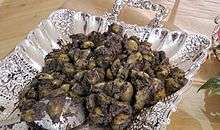
Kateh is the traditional dish of Northern Iran (provinces of Gilan, Mazandaran and Golestan) and is simply Iranian rice cooked in water, butter and salt until the water is fully absorbed. This method results in rice that is clumped together and is the predominant style of cooking rice in the Caspian region. In Gilan, Golestan and Mazandaran, kateh is also eaten as a breakfast meal, either heated with milk and jam, or cold with Iranian cheese (panir) and garlic. Kateh is commonly eaten in other parts of Iran because of its short cooking time and easy preparation, and is prescribed widely as a natural remedy for those who are sick with the common cold or flu, and also for those suffering from stomach pains and ulcers. Some of the foods like Chegdermeh are only used in the Turkmen region of Golestan Province, but many other dishes are used in all parts of Iran.
Iranian caviar and Caspian fish roes hails from that region, and is served with eggs, in frittatas (Kuku sabzi) or omelettes. The cuisine of this region has the most affinity with other cuisines of the wider Caucasus region. (see Caucasian cuisine)
Northern Iran is home to the most numerous list of recipes compared to other regions. The most favorite dishes of this region are:
|
|
|
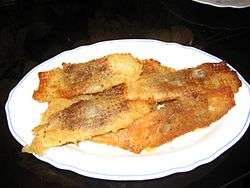
The Gilan, Mazandaran and Golestan provinces variety of rice is considered one of the best in Iran, where it has been in use since the fourth century BCE.
Eating fresh raw broad beans is common in Gilan, Mazandaran and Golestan provinces, either alone or with cooled Kateh and salted fish eggs (Ashpel); but selling and enjoying (especially by people of the lower classes) of hot cooked broad beans (bāqelā-garmak) sprinkled with salt and powdered Persian marjoram (golpar) are not an uncommon street scene in cold weather almost everywhere in Iran. The Gilani dish Baqali Qatoq is cooked with dill, garlic, and turmeric, into which eggs are emptied at the end.[15]
Khuzestan
Seafood is the most important part of Khuzestani cuisine, but many other dishes are also featured. The most popular Khuzestani dish is Ghalieh Mahi, a popular fish dish that is prepared with heavy spices, onions and cilantro. One of the fish used for grilled fish is locally known as mahi soboor (shad fish), a species of fish found in the Arvand river (Arvand rood). Other provincial specialties include Ghalieh Meygu ("shrimp stew"), ashe-mohshala (a Khorramshahri breakfast stew), sær shir (a Dezfuli breakfast of heavy cream), hælim (a Shushtari breakfast of wheatmeal with shredded lamb), and kohbbeh (a deep-fried rice cake with ground beef filling and other spices of Arabic origin, a variant on Levantine kibbeh).
Esfahan

Esfahan in Central Iran is home to dishes and delicacies such as:
| Status | Dish | English name | Description |
|---|---|---|---|
| Well known or culturally significant | Fesenjān (فسنجان) | a casserole with a thickly tart sauce containing the two base ingredients: pomegranate purée and ground walnuts. It is cooked with either chicken, duck, lamb or beef and served with rice. | |
| Gaz (گاز) | the name given to Iranian nougat using the sap collected from angebin, a plant from the Tamarisk family found only on the outskirts of Esfahan. It is mixed with various ingredients including rose water, pistachios, almond kernels and saffron. | ||
| Sohān-e-Asali | Honey Toffee | A brittle toffee made from honey and butter, flavoured with cardamom and saffron, and coated with slivered almond and pistachio kernels. | |
| Khoresht-e-mast (فسنجان) | Yogurt Stew | Unlike other stews it is not served as a main dish and with rice; since it is more of a sweet pudding it is usually served as a side dish or dessert. The dish is made with yogurt, lamb/mutton or chicken, saffron, sugar and orange peels. Iranians either soak the orange peels in water for one week or longer or boil them for few minutes so the orange peels become sweet and ready for use. This dish often accompanies celebrations and weddings. This dish differs from the Shirazi dish with the same name. | |
| Notable | Berian/Beryun (بریانی) | This dish is made of mutton or lamb which is ground/minced and then cooked on one side in a special small pan over open fire. Berian is generally eaten with a certain type of bread, known as "nān-e-taftun". It is also served with rice. | |
Iranian Azerbaijan

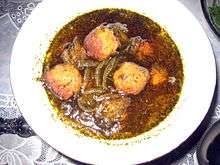
- Ghabli
- This traditional dish in Azerbaijan is made of rice, lentils, meat, potatoes and groats.
- "the torn abdomen" in Azeri
- A kind of Kofteh that are unusually large.
- Tabriz is notable for its delicious cookies and confectioneries in Iran, some of which are
- Ghorabiye
- Eris
- Nogha (نُوقا in Persian and Azeri): A special kind of Gaz made mainly in the Azeri regions of Iran. Nogha is almost exclusively made with walnuts instead of pistachios and almonds which are usual for other types of Gaz. The making of Nogha is very much the same as any other Gaz. The difference is that Nogha is usually spread between two very thin layers of wafers and cut into 10x5x5cm sections which are larger than ordinary Gaz cubes.
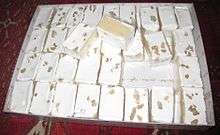
- Āsh is popular thick soup in Azerbaijan. It comes in variants with different ingredients. The word Āsh had passed from Persian into the Central Asian Turkic languages.[16]
- Bozbash (green vegetable stew): It is a kind of Abgoosht, made with meat (usually lamb), red or white beans, green vegetables, herbs (e.g., parsley, fenugreek, mint), onions and leeks, dried limes (limo-ye ʿomani), and spices (mainly salt, pepper, and turmeric). These ingredients are simmered together in water over low heat for several hours. As with most Abgooshts, when the ingredients are thoroughly cooked, the solids are usually removed and mashed to a pulp, known as gusht-e kubideh. The broth and the pulp are then served separately with flat bread and a pickled green-vegetable relish.[17]
Varieties of Azerbaijani Āsh include:
| Aash | Translation |
|---|---|
| Gurudlu Āsh | Dried Whey Thick Soup |
| Turshulu Āsh | Sour Thick Soup |
| Yogurtlu Āsh | Yogurt Thick Soup |
| Isfanaj Aashi | Spinach Thick Soup |
| Āsh Mast | Yogurt Soup (in Ardabil) |

Traditional table settings and etiquette
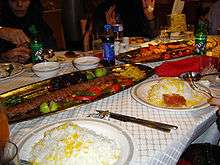
The traditional Iranian table setting firstly involves the tablecloth, called sofreh, and is spread out over a Persian rug or table. Main dishes are concentrated in the center, surrounded by smaller dishes containing appetizers, condiments, side dishes, as well as bread, all of which are nearest to the diners. These latter dishes are called mokhalafat (accompaniments). When the food has been served, an invitation is made to all those seated at the sofreh to help themselves. Many Iranians continue to use bread or rice to eat their meals.
Structure of meals
Breakfast
Breakfast is called sobhāneh (Persian: صُبحانِه) or nāshtāyi (Persian: ناشتايى). The basic traditional Iranian breakfast consists of a variety of flat breads (nān-e sangak, nān-e lavāsh, nan_e barbari and others), butter, Tabrizi white cheese (panir), feta cheese, whipped heavy cream (Sarshir, often sweetened with Sabalan honey), or a variety of fruit jams and spreads.
Other popular traditional breakfasts (which require far more preparation) include haleem (wheatmeal served plain or more commonly with shredded lamb or turkey - similar to Western oatmeal in some respects) and āsheh mohshālāh (thick soup). These latter breakfasts are typically regional specialities, and many cities and towns all across Iran feature their own distinct versions of these dishes. Both āsheh mohshālāh and haleem are typically prepared the night before, to be served the next morning, and haleem is usually only served at certain times of the year (haleem specialty restaurants are only open during those times), except in southern parts of Iran, where haleem is always present. Kaleh paacheh (lit. sheep's entire head and its hooves) a popular traditional dish widely eaten in Iran and the neighbouring Caucasus region, is almost always only served from three in the morning until sometime after dawn, and specialty restaurants (serving only kaleh paacheh) are only open during those hours.
Lunch and dinner
Lunch and dinner (naahaar va shaam) are not distinguished in Persian. Traditional Iranian cooking is done in stages, at times needing hours of preparation and attention. The outcome is a well-balanced mixture of herbs, meat, beans, dairy products, and vegetables. Major staples of Iranian food that are usually eaten with every meal include rice, various herbs (mint, basil, dill, parsley), cheese (feta or Iranian panir, derived from goat, sheep, or cow's milk), a variety of flat breads, and some type of meat (usually poultry, beef, lamb, or fish). Stew over rice is by far the most popular dish, and the constitution of these vary by region. Tea (chai) is the drink of choice on nearly every occasion, and is usually served with sugar cubes made from sugar beets called Ghand, (Persian: قند), dried fruit, pastries, or sweets.
Tea can be found brewing throughout the day in most Iranian homes. Doogh, a yogurt drink, is also quite popular. One of the oldest recipes, which can trace its existence back to the time of the Persian empire, is khoresht-e-fesenjan, consisting of duck or sometimes chicken in a rich pomegranate-and-walnut sauce that yields a distinctive brown color, most often served with white rice.
Using dairy products in Iranian cuisine has an old historical background, as an example, Kashk (dried condensed whey) is used in dishes like Kallajush. It consists of fried onions, dried herbs, and boiled Kashk, eaten with bread (crumbled or in pieces). Foods containing kashk, including kallajush, have been common among tribal peoples and villagers for centuries, especially in wintertime, as it is both easily prepared and affordable for low-income families. Kashk is quite nutritious and contains protein and calcium. Kashk processing was one of the easiest and most effective ways of conserving dairy products in hot climates during pre-modern times.[18]
Fast food, imported and adapted foods
Popular fast food items in Iran include Chelow kabab (literally "rice and kabaab"), Jujeh kabab (the same, but substituting grilled or broiled chicken), nān o kabāb (literally "bread with kabab"), kabab sandwiches, and a number of different derivatives of traditional slow-cooked meals. An increasing preference for American-style food amongst a younger generation of Iranians has resulted in the establishment of many pizza, steak, hamburger, and fried chicken establishments, but Western food is sometimes served alongside staples such as those mentioned above, and is often prepared differently (most notably with pizza). Chinese and Japanese cuisine has also become popular in recent years, primarily in Tehran, and Italian and Mediterranean restaurants are also featured. The noted influence of European and American culture before the Islamic Revolution has also imparted preparations such as bechamel, gigots, milanesas, and others to Iran.
Historical Iranian cookbooks
Although the Arabic cookbooks written under the rule of the Abbasid Caliphate include some recipes with Iranian names and clearly derived from Iranian cuisine, the earliest classical cookbooks in Persian that have survived are two volumes from the Safavid period. The older one is the Kār-nāmeh dar bāb-e tabbākhī va sanat-e ān ("Manual on cooking and its craft") written in 927/1521 by Ḥājī Moḥammad-ʿAlī Bāvaṛčī Baḡdādī for an aristocratic patron at the end of the reign of Shah Esmail. The book originally contained 26 chapters, listed by the author in his introduction, but chapters 23 through 26 are missing from the surviving manuscript. The recipes include measurements for ingredients; often detailed directions for the preparation of dishes, including the types of utensils and pots to be used; and instructions for decorating and serving them. In general the ingredients and their combinations in various recipes do not differ significantly from those in use today. The large quantities specified, as well as the generous use of such luxury ingredients as saffron, suggest that these dishes were prepared for large aristocratic households, even though in his introduction, the author claimed to have written it "for the benefit of the nobility, as well as the public".
The second surviving Safavid cookbook, Māddat al-ḥayāt, resāla dar ʿelm-e ṭabbākhī ("The substance of life, a treatise on the art of cooking"), was written about 76 years after the Kār-nāmeh by Nūr-Allāh, a chef for Shah Abbās. The introduction of that book includes elaborate praise of God, the prophets, the imams, and the shah, as well as a definition of a master chef. It is followed by six chapters on the preparation of various dishes: four on rice dishes, one on qalya, and one on aash. The measurements and directions are not as detailed as in the Kār-nāmeh. The information provided is about dishes prepared at the royal court, including references to a few that had been created or improved by the shahs themselves; other contemporary cooks and their specialties are also mentioned.[19]
Iranian cuisine abroad
Iranian cuisine is not widely recognized and is sometimes confused with other Middle Eastern cuisines such as Arab cuisine. Many Iranian super-markets and restaurants are labelled as Middle Eastern, Mediterranean, or "International" to broaden their appeal to the European or American consumer.[20]
Turkish cuisine, Azerbaijani cuisine and Iranian cuisine on the other hand have heavy mutual influence on each other, due to geographical proximity, many common cultural aspects, shared empires, and ethnic relations. For example, Azerbaijani Turks are the second largest ethnicity in Iran.These influences are seen in its kebabs and other dishes due to cultural contacts with Iranic peoples and Turkic peoples. Iranian cuisine is gaining popularity in multicultural cities like London, Los Angeles, Vancouver, Washington, D.C., and Toronto, which have significant Iranian populations.[21][22] Los Angeles and its environs, in particular, are well known for the number and quality of Iranian restaurants which are usually centered around kebab, but almost always also serve various Iranian stews and other traditional dishes.
Gallery
-
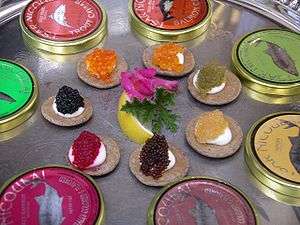
Iranian caviar
-
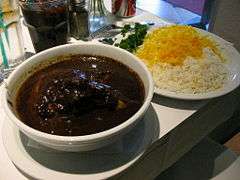
A bowl of chicken fesenjan, with Iranian rice
-
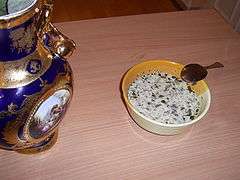
Ash-e doogh (Yogurt soup) of Ardabil
-
Shekarpareh (Sugar candy) of Khorasan
-
Iranian Kashk
-

Iranian Sofreh (traditional Iranian table setting)
-
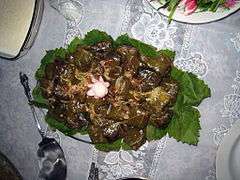
Iranian grape vine leaves dolmeh (Tabriz)
-

Ashe Reshteh (with Kashk)
-
Morasa-Polo (Jeweled rice)
-
Potato tahdig
See also
- Advieh
- Agriculture in Iran
- Berberis vulgaris -Zereshk
- Culture of Iran
- Ghelyan
- Gondi dumpling
- Juglans regia (Iranian walnut)
- Middle Eastern cuisine
- Samanu
- Tarkhine
- Zamzam Cola
References
- ↑ "Persian Cuisine, a Brief History". Culture of IRAN. Retrieved 2016-01-08.
- ↑ ĀŠPAZĪ
- ↑ "Iranian Food". Retrieved 13 April 2014.
- ↑ "Culture of IRAN". Cultureofiran.com. Retrieved 13 April 2014.
- ↑ Stanton,; et al. (2012). Cultural Sociology of the Middle East, Asia, and Africa: An Encyclopedia. SAGE Publications. p. 103. ISBN 978-1452266626.
- ↑ Elāhī, ʿE. "ĀŠ(thick soup), the general term for a traditional Iranian dish comparable to the French potage.". Encyclopedia Iranica. Retrieved 2016-02-08.
- ↑ "Weird Iranian Dish: Sheep's Head and Hooves". YouTube. 2011-01-23. Retrieved 2016-01-08.
- ↑ Fragner, B. (1987). ĀŠPAZĪ. Encyclopaedia Iranica.
- ↑ Ghanoonparvar, M. R. "Dolma". Encyclopedia Iranica. Retrieved 2009-04-05.
- ↑ Ramazani, Nesta. "Uses of the Fruit in Cooking". Encyclopedia Iranica. Retrieved 2008-10-11.
- ↑ Ramazani, N. "ĀB-ḠŪRA". Encyclopedia Iranica. Retrieved 2011-06-26.
- ↑ Some Iranian Pastries with images
- ↑ Elāhī, Etrat. "ḤARIRA a very light and diluted Iranian dish made of fine wheat flour or wheat starch, or with rice flour or rice powder.". Encyclopedia Iranica. Retrieved 2016-02-08.
- 1 2 3 Batmanglij, Najmieh. "FISH iv. FISH AS FOOD". Encyclopædia Iranica. Retrieved 2015-08-03.
- ↑ Aʿlam, H. "BĀQELĀ". Encyclopedia Iranica. Retrieved 2009-04-07.
- ↑ Fragner, B. "ĀŠPAZĪ". Encyclopedia Iranica. Retrieved 2009-03-13.
- ↑ Ghanoonparvar, Mohammad R. "BOZBĀŠ". Encyclopedia Iranica. Retrieved 2013-05-01.
- ↑ Elahi & EIr, Etrat. "KALLAJUŠ". Encyclopedia Iranica. Retrieved 2013-05-01.
- ↑ Ghanoonparvar, Mohammad R. "Cookbooks". Encyclopedia Iranica. Retrieved 2009-04-05.
- ↑ "Home - Wonderful dishes Kofteh Tabrizi Special Kababs". Azerbaijan restaurant. Retrieved 2016-02-16.
- ↑ "The 10 best new restaurants in Toronto in 2013". The Globe and Mail. Retrieved 2016-02-16.
- ↑ Dehghan, Saeed Kamali (2016-02-03). "Top five Persian restaurants in London". The Guardian. ISSN 0261-3077. Retrieved 2016-02-16.
Further reading
| Wikimedia Commons has media related to Cuisine of Iran. |
| Wikibooks Cookbook has a recipe/module on |
- Daniel, Elton L.; Mahdi, Ali Akbar (2006). Culture and Customs of Iran. Greenwood Press. pp. 149–155. ISBN 978-0-313-32053-8.


